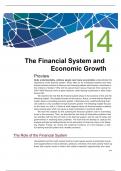Summary
Summary The Financial System and Economic Growth
- Course
- Institution
The Role of the Financial System Households and firms with surplus funds to invest require access to productive investment opportunities in new businesses, products, and ideas. How does society match up those with surplus funds to others with viable investment opportunities who need funds? And how...
[Show more]



